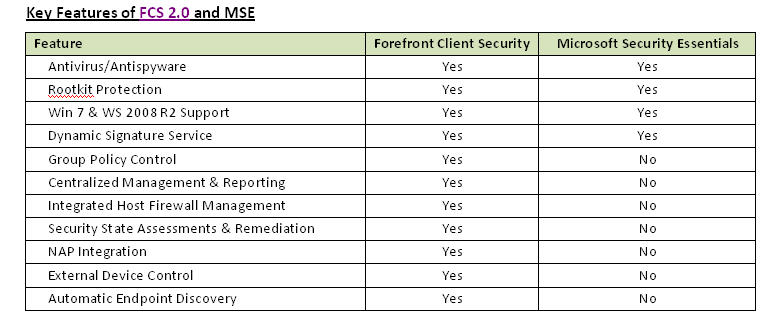Microsoft Security Essentials or Forefront: Which should a Windows user choose?

It's been a while since Microsoft has shared any new information about its free antimalware offering, Microsoft Security Essentials (codenamed "Morro"). But the Softies are quietly setting the stage for the product, which is slated to launch before the end of the year.
A quick refresher: MSE is the replacement for Windows Live OneCare and a superset of Windows Defender. Microsoft officials have said it is meant for consumers who are unwilling or unable to pay for security software. A number of Microsoft watchers are expecting the final version of MSE to debut in October, given that it is meant to work on XP, Vista and Windows 7 -- and Windows 7 launches on October 22. More than 400,000 testers have downloaded the test version of MSE, according to Microsoft.
Microsoft has another client-based security offering, its Forefront Client package -- which, as of early September, supported Windows 7 and Windows Server 2008 R2 (but not yet the server core offering). There's a new version (part of its "Stirling" family), which is currently in its second beta release and expected to launch in final form in the first half of 2010. The final name for the new release will be "Forefront Endpoint Protection 2010."
While the core engine of MSE is the same as what's in Forefront client, Forefront also provides security management capabilities that aren't in MSE, such as group policy control, NAP integration and integrated host-firewall management. Unlike MSE, Forefront client is not free; Microsoft is selling the product for $12.72 per user or device per year, according to a chart on its Web site. (It's not clear whether this also will be the price for the new version next year.)
Microsoft is pitching Forefront client as its security offering for business users of any size, from the smallest business to the largest enterprise. It is pitching MSE as being for consumers and not designed for business use.
Here's Microsoft's positioning chart, comparing the two offerings. (Click on it to enlarge.)

Microsoft made the decision to combine its security and identity teams a year and a half ago, based on the realization that the majority of attacks (86 percent, according to Microsoft's research) were happening at the application and data levels, rather than the operating-system level.
"We need protection to be more identity-aware, and access to be more security aware," said John "JG" Chirapurath, a Director in Microsoft's Identity and Security Business Group. The idea is "protect eveyrwhere and access anywhere, from on-premise or in the cloud."
I continue to get a lot of questions about MSE pricing and availability from business users, leading me to wonder whether budget pressures might end up playing a big role in terms of which security product customers who plan to use Microsoft's offerings end up choosing. Any business users out there testing MSE? Does its lack of management capabilities -- or anything else about the product -- make it a nonstarter for you?